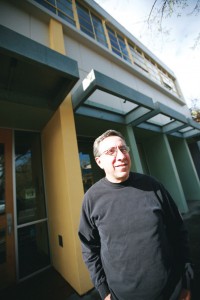David Mogavero
Posted on April 4, 2011 – 6:34 AM | by AdminBy James W. Cameron Photos by Scott Duncan
As he settles comfortably into a couch in his Midtown office, David Mogavero’s professorial look and serious demeanor are offset by the twinkle in his eye and the fervor of his speech. He talks about his abiding passion, the future of cities in general, and Sacramento in particular.Infill development, critical to the future of the Sacramento region and the well being of its citizens, is an amour to which he’s devoted over thirty years of his life.
 As former President of the Environmental Council of Sacramento, the Planning and Conservation League, and the Old City Association, and current Board member of ECOS, Mogavero’s interest spans ecological building, environmental planning, infill development, urban design, and energy efficient design – all critical to the green development of cities in this age of increasing population.
As former President of the Environmental Council of Sacramento, the Planning and Conservation League, and the Old City Association, and current Board member of ECOS, Mogavero’s interest spans ecological building, environmental planning, infill development, urban design, and energy efficient design – all critical to the green development of cities in this age of increasing population.
“[He’s] the real deal, a man of vision and caring,” says Brooks Truitt, Midtown’s resident iconoclast. “Mogavero was the person most responsible for the preservation of the R Street Corridor in the face of enormous pressure to turn it into another high rise office filled abomination. Now, plans for its development as a vital, mixed use, central city neighborhood have gained momentum and are moving forward.”
The R Street Corridor battle was typical of Mogavero’s devotion to his subject. Once a thriving warehouse district that bisected the north and south sections of downtown, it slowly deteriorated into blight. Many in the city wanted to add R Street to a long list of central city tracts punctuated by mega story office buildings. A ten year battle, led by
Mogavero and his good friend Steve Sanders, led to a resolution in 1996 to preserve the corridor for mixed use development.
Today the R Street Corridor is a twenty seven block long, two block wide special planning district crossing the central city. The goal of the designation is to preserve historic features while providing effective transit systems as well as encouraging pedestrian traffic, open space and neighborhood facilities in a mix of commercial and residential uses. Several improvements are already in place including an art gallery and artists’ studios, condominiums, several restaurants and light rail transit. Mogavero muses over the lengthy effort. “We walked door to door and hand distributed five thousand copies of pamphlets every week during the critical decision period to get public opinion behind the effort. It paid off.”
Born to a blue collar family of, in his words “barbers and butchers,” Mogavero left his Rochester roots behind and wandered west to San Francisco after an education in architecture that began at Ohio State University and ended at the State University of New York. “I was a lousy student,” he grins. “I did my first building in Rochester, a sustainable house, for which my commission was a backpack! In San Francisco I washed dishes at a Hilton Hotel and did small house jobs, then worked for a group of thirty Baptist ministers on the Western Addition. After a stint as a project manager for a San Jose construction company, I made the move to Sacramento and have been here ever since.
“In the early eighties, there was little interest in sustainable building and even less In preserving Sacramento’s central city, and I stepped into that void, joining a cadre of maybe a dozen others with those interests. From that point on, that’s been my focus, sustainable city planning and infill projects.” For the past 25 years his firm, Mogavero Notestine Associates, has been consistently devoted to sustainable growth through innovative and functional urban infill development and renovation.
So what is sustainable or green growth? “It’s the revitalization of existing communities and neighborhoods, pedestrian-friendly streets and developments,” says Mogavero. “It’s human based architecture, environmentally safe building materials, economic sustainability, and participation in the planning and design process by the end users. We also offer traditional architectural services to a full range of public and private clients but we always stress green design.”
Among the exciting ventures undertaken by Mogavero-Notestine has been the SMUD Customer Service Center where the firm’s naturally lit design and state of the art workplace ergonomics resulted in a thirty three percent reduction in employee absenteeism – and numerous awards. Perhaps the most familiar is the Metro Square development, a much heralded project encompassing forty five single family homes In Midtown that transformed the central city housing market. Yet another was the Southside Park Co-Housing project, a catalyst for the rebuilding of the historic Sacramento neighborhood.
The Mogavero Notestine firm also provided architectural and development services to the Greater Sacramento Urban League’s Workforce Training Center, designing a number of lighting, cooling and heating systems that reduce energy use and enhance productivity. An important current project is Mercy Housing California, a building at 7th and H that will provide 150 affordable housing units for formerly homeless individuals over ground floor retail space and a clinic for residents. “It’s an exciting project,” says Mogavero. “It will benefit a lot of people who need help and benefit the city as well.” Design which benefits people as well as the city is clearly important to him.
With so many testaments to his success and that of the firm, what’s next for Mogavero? “Suburban development, done right, is the key to the future. We’re involved in an affordable mixed used project in old Roseville right now.” Then he looks pensive, somewhat wistful. “And I haven’t designed a house in twenty years,” he muses, and I’m working on one now. It’s a nice change of pace.”


